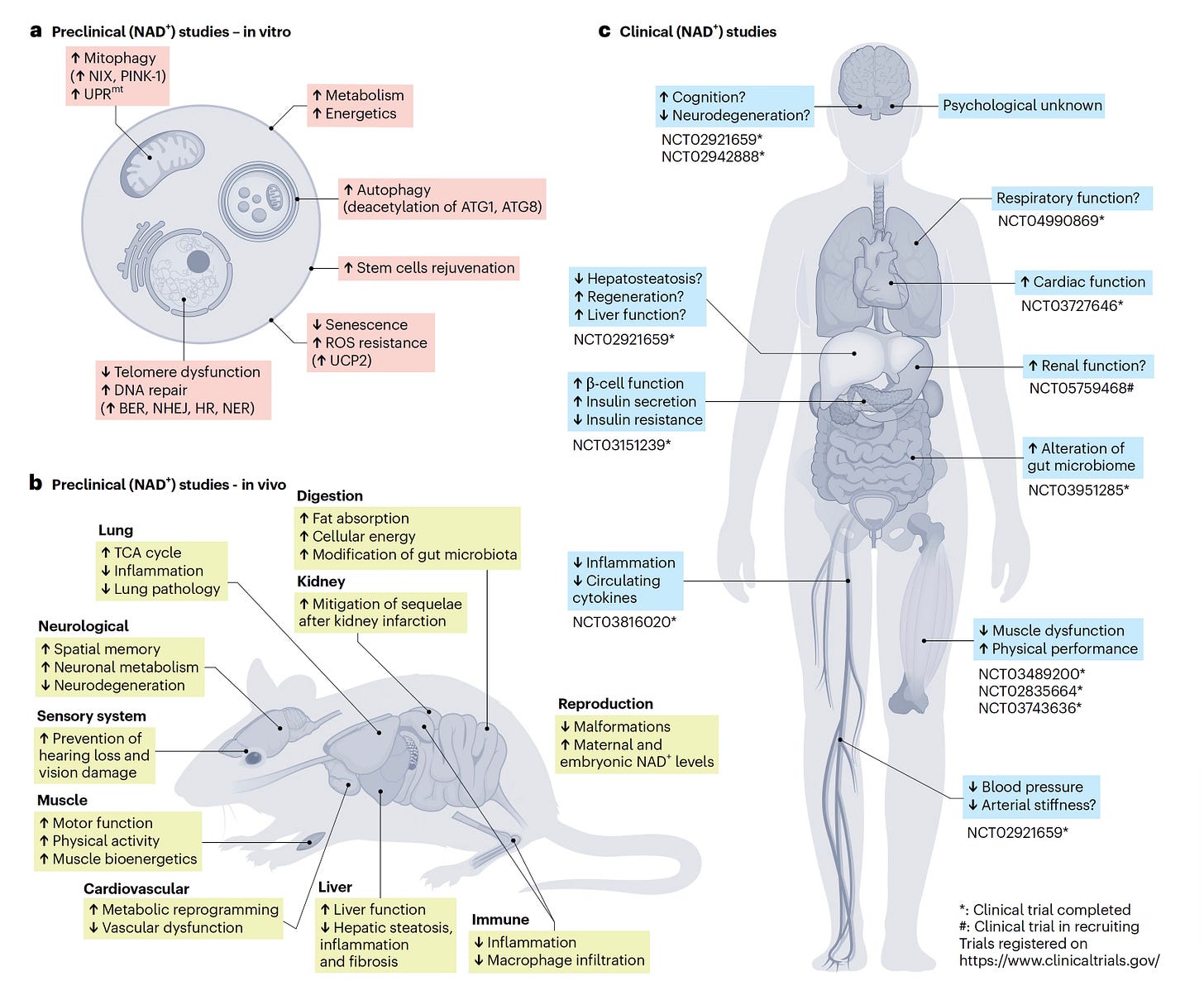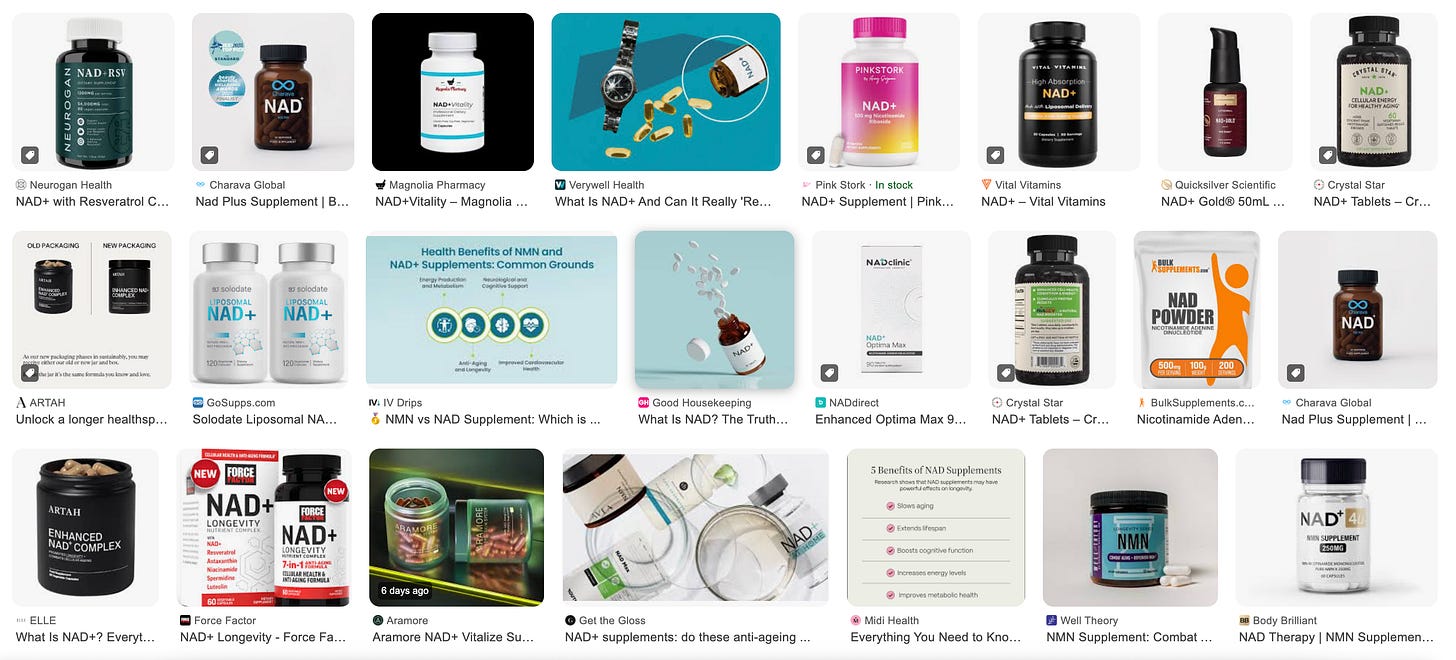CheatSheet: NAD+ longevity supplements
Harvard & MIT researchers helped create a lucrative supplement market despite zero clinical proof that their products work.
What’s in this post:
The fundamental market advantage of supplement sellers over buyers.
Thesis: The NAD+ debate: is there proof it works in people?
What are sirtuins and NAD+? A plain-English overview.
The two scientists generating the NAD+ hype cycle: how they did it.
Hitting the resveratrol jackpot, and how resveratrol paved the way for NAD+.
Profitable consequences: When research PhDs exaggerate their own science.
There’s a reason you’ve been hearing more about NAD+ shots and supplements lately without feeling like you actually understand what NAD+ is, what it does, how it works, whether it’s worth trying or even why it has become, among celebrities and the so-called “worried well,” such a thing now.
That lack of scientific clarity, I argue below, is partly by design.
When it comes to longevity supplements, ambiguity favors the PhDs selling them for a profit more than the consumers buying them on a prayer.
“In the longevity field…there are individuals who publish high-profile papers, who have a very vested interest in a particular model. And then they publish high-profile reviews where they talk about these things as if they are established fact.”
— Matt Kaeberlein, a prominent sirtuin researcher, April 2024
This post has a simple thesis: NAD+ may eventually be clinically proven to help people age slower and better, but so far there’s zero proof. That lack of evidence hasn’t prevented it from becoming a popular longevity supplement — especially among those on the Hollywood/Instagram axis. At the core of this massive uptick in NAD+ interest are two scientists, at Harvard and MIT, who for years have flooded the zone with research that, coincidentally or not, gave them a clinical basis to sell online sirtuin/NAD+ pills to consumers who may, or may not, receive a benefit.
But first, in case you missed it:
To keep this post as concise as possible, I’ll stay at a non-clinical level of detail to illustrate how talented but ambitious scientists intent on cashing in on their work can use prestigious medical research publications to foster a misleading narrative that provides those scientists lucrative business opportunities.
This isn’t a rare occurrence. In a longevity industry worth an estimated $5.6 trillion1, it’s become a trend.
TREND: A scientist at a prominent lab publishes research suggesting a promising new way to slow or reverse aging. He (they’re almost all men) joins with MBA types to sell an online supplement derived from that research, though the data on humans is inconclusive at best. Other researchers eventually dispute his public claims, but it’s too little, too late! The scientist and his partners, aided by social media influencers, have already developed their unproven product into a lucrative side hustle in the trillion-dollar longevity marketplace.
In plain English: What are sirtuins and NAD+?
Sirtuins are proteins in your cells that act like maintenance workers. They help repair DNA damage and keeping your cellular machinery running smoothly as you age. There are seven different sirtuins in humans (SIRT1 through SIRT7). They also help regulate everything from brain, immune and circadian function to fat metabolism and blood sugar. To function, however, sirtuins need NAD+, a molecule that is present in every cell of your body and is essential for life. (NAD stands for nicotinamide adenine dinucleotide.)
NAD exists in two forms that function as a pair:
NAD+ (the oxidized form) has a positive charge, ready to accept electrons
NADH (a reduced form, where H is hydrogen) is neutral, carrying electrons
These two forms work together in your cells. NAD+ picks up electrons (and hydrogen) during the breakdown of food, becoming NADH, which delivers those electrons to your mitochondria to generate energy and then turns back into NAD+. This cycle occurs constantly, in every cell, thousands of times per second, to keep you alive.
If you find this reporting helpful, please subscribe (or make a one-time donation). Quality reporting matters. Your support matters.
Will NAD+ therapies be proven to offer positive health impacts on humans? Time will tell. Thus far, there has been no clinical consensus that it does2; some reputable scientists are cautiously optimistic, while others are not. Studies continue to publish on both sides of that clinicial aisle.
We may find out sooner rather than later, however. The day before this post published on AGING with STRENGTH, the journal Nature Aging printed a new NAD+ paper with 28 authors — including two mentioned in this post.3
The graphic below, from that study, provides a helpful overview of NAD+ functions in cells, mice and humans, with references to correlated studies.

(As you read further, keep the above study in mind, because it illustrates a central point about the growing number of conflicts of interest in clinical research that I mention below.)
Sirtuins, discovered in the 1970s, have been in the scientific literature for decades. They became famous in the late 1990s when research first suggested that activating them in yeast could mimic the life-extending effects of calorie restriction — eating less while staying healthy — which had been shown to help various organisms (but not humans, really) live longer.
Here’s the critical twist:
NAD+ may precipitously decline with age4, thereby inhibiting the ability of sirtuins, which rely on NAD+, to help keep cells healthy, well and, just maybe, young.5
NAD+ and the scientist-led hype cycle
But, what if, instead of just losing our NAD+ supply as we age, people could keep topping it off with further supplements and injections, to give our sirtuins all the juice they need to continue repairing and rejuvenating our cells?
Or, in the PT Barnum-like parlance of David Sinclair, a serial dissembler and controversial6 Harvard geneticist who has falsely claimed to have reversed aging in dogs7; suggested a pill may soon reverse aging in humans; and regularly exaggerates his research:
What if human manipulation of NAD+ could slow aging?
In fact, in 2016, Sinclair published a paper on sirtuin/NAD+ with that exact, provocative, and, it turns out, unsupported title: “Slowing ageing (sic) by design: the rise of NAD+ and sirtuin-activating compounds.”8 I say unsupported because the
Keep reading with a 7-day free trial
Subscribe to AGING with STRENGTH® to keep reading this post and get 7 days of free access to the full post archives.





